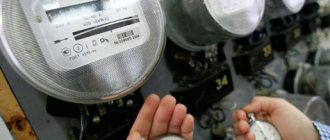Often, when buying a refrigerator for their home, most people are only interested in the appearance and price, and only then the power consumption of the refrigerator. As statistics show, a significant part of buyers make their choice in favor of a famous company, thereby justifying the huge costs of advertising. Many people don't realize that a cooling appliance's electricity use accounts for about 30% of monthly consumption. Every year, savings become more and more relevant, and when purchasing, it would be useful to pay attention to the power consumption in kilowatts (kW), because the refrigerator is constantly connected to the network and consumes electricity 24 hours a day, 365 days a year.
The characteristics of the device are indicated in the instructions for the refrigerator, but if you do not have it at hand, they can be found on the information sticker located on the back wall or inside the refrigerator compartment. The average power is in the range from 100 to 200 watts per hour, this power is enough to maintain a temperature of -5°C in an environment of +25°C.
What function is affected by the power of the refrigerator?
The power of a refrigeration unit directly affects its energy efficiency and also affects the operation of its additional functions.
Energy efficiency is determined by the rational use of electricity by a device. Thus, a class A refrigerator consumes an average of 100 watts per hour, 1.5 kW per day, and over the course of a year this figure can vary between 365-550 kW. What consumption you reach depends on how correctly the owner uses his refrigerator.
Freezing power is an indicator that determines how much food (in kg) the freezer is able to freeze in one day.
The information sticker contains information with the indicator “X***”. The number of stars next to the symbol depends on the amount of food being frozen. The freezing power rating is measured in kilograms per day and indicates the amount of food (in kg) that it can cool to a temperature of -18°C in 24 hours. The default room temperature of food is +18-20°C. For ordinary household refrigerators, when used in a single-family home (of 3-4 people), the freezing capacity should not be lower than 9 kg/day.
What does consumption depend on?
How much electricity a refrigerator consumes per month in watts depends on the following parameters:
- energy class;
- volume of the common chamber of the refrigerator and freezer;
- compressor power level;
- presence or absence of a second compressor;
- quality of seals;
- number of lighting elements;
- the presence of an additional option for dry freezing and an ice maker;
- the presence of an electronic clock and other similar functions on the case;
- temperature conditions maintained in the device chamber.
The list of additional factors influencing energy consumption includes the frequency of opening a household device and the temperature in the room. It is not recommended to install refrigeration equipment near an oven, microwave oven, electric stove and other heated electrical appliances. Otherwise, the power consumption of the unit will increase.
What are the classes?
An inexperienced consumer can easily get confused about energy efficiency classes. Moreover, the instructions were revised more than once, becoming more complicated each time. Since 2014, amended standards have been in force, dividing devices into classes (table below).
The table shows that the higher the class, the lower the percentage value of the index, and at the same time the energy consumption of the model.
Important! This gradation applies exclusively to refrigerators and free-standing freezers. Other equipment (washing machines, split systems, etc.) operates with different indicators.
Class A
A little earlier, equipment was classified by letters from A to G. Over the last ten years, even more economical products with a reduced index have appeared. Therefore, pluses began to be added to the letter A - from one to three. Models with this index today occupy almost two-thirds of the entire refrigeration market.
It turns out that equipment in the same category can have completely different energy efficiency. That is, Class A refrigerators are considered energy-saving, while A+++ devices are more than twice as superior to them in this regard: 50% versus 22% (see table).
BG classes
There are still equipment on sale with energy efficiency class B-D. But in five to ten years no one will remember about them, as happened with the EG category models. Naturally, it is not advisable to buy a refrigerator with a high energy efficiency index (B or C).
Advice! The best option for the budget and mid-budget segment is A+ or A++. Almost all premium models come with the prefix A+++.
Possibilities for reducing power consumption
To reduce energy costs, you can use the following professional tips:
- It is necessary to determine the list of necessary functions of the refrigerator and its volume. If the number of users is not large, there is no point in purchasing a large device with newfangled additions and functions. This will only lead to inefficient consumption of electrical energy.
- You should not purchase refrigerators of a low energy saving class. Some models "Atlant" and "Biryusa" have class "B". Today's savings will result in high costs during operation.
- When purchasing, it is advisable to evaluate all the characteristics of the refrigerator. Analyze existing reviews from owners.
- Use LED devices in the internal lighting system. They are much more economical than incandescent lamps, more durable, and highly economical.
- Using the energy-saving mode during long-term non-use of the device, for example, on vacation, will reduce energy costs.
- It is necessary to ensure that the refrigerator doors are not left open for a long time. According to experts, such negligence increases energy consumption by 70%. Modern refrigerators Atlant, Indesit, Stinol, Lg have a built-in electronic temperature sensor. It is equipped with a sound signal that sounds when the temperature drops below the permissible level.
- Monitor the condition of the seals. They ensure tightness inside the refrigerator and freezer compartments.
- Ensure good ventilation between the back of the refrigerator and the wall of the room.
- Check the temperature of food loaded into the refrigerator. Do not place food or utensils at elevated temperatures. This will require additional energy for cooling and subsequent freezing.
- Monitor the condition of the refrigerator walls. Do not allow them to become heavily icy. Carry out periodic ice removal and completely defrost the device every six months, followed by cleaning and drying.
Annual energy consumption of the refrigerator
Such equipment works year after year and consumes expensive kilowatts day and night. The larger and more functional the equipment, the more electricity it consumes.
To calculate the annual consumption, it is necessary to clarify the power of the device or the peak load current. All data of this kind must be indicated in the instruction manual or brief specification, which is presented on the box.
If the documentation has not been preserved, then you can estimate the approximate consumption taking into account the energy saving class:
- A – 150-300 kW;
- B – 350-600 kW;
- C/D – 600-900 kW.
To calculate your energy costs, you need to multiply these figures by the current tariffs for your region. For example, if you have an A+ class refrigerator in a Moscow apartment, you will have to pay 807 rubles per year: 150 kW * 5.38 rubles. While for equipment of category B you will need to pay about 2000 rubles: 400 kW * 5.38 = 2152.
You can also calculate the annual consumption by knowing the load current. We calculate the power (amps * volts) and, taking into account the average operating time of the compressor per day (about 6 hours), we get an approximate value in kW. For example, 1.2 A * 220 V = 264 W = 0.26 kW. Next, 6 hours * 0.26 = 1.56 kW per day. We multiply the resulting figure by the number of days in a year, and then by the tariff (in our case for the capital - 5.38). In total, you need to pay 3063 rubles per year: 365 d * 1.56 kW = 569.4 kW * 5.38 = 3063.
Criterion importance
Along with the power of the compressor and the volume of the freezer, the energy consumption of the refrigerator is the most important parameter that must be taken into account by the consumer when choosing equipment. Why is it important? Unlike the entire range of household appliances, the refrigerator works around the clock, producing cold and consuming a certain amount of electricity for this work. Energy consumption indicates to the user the “gluttony” of the equipment. The production of hundreds of kilowatts of electricity consumed requires natural resources, which, unfortunately, are not unlimited.
By choosing a refrigerator with a high energy saving class, the consumer saves not only the family budget, but also the natural resources of the planet, no matter how pretentious it may sound.
On a note! The classification of energy consumption of modern refrigerators allows the consumer to conclude what financial costs it will cost to maintain the model.
Consumers often confuse the concepts of energy consumption and energy efficiency. Unlike “gluttony,” the energy efficiency index shows the relationship between the amount of energy consumed and the work done. In other words, how many kilowatts of electricity will the device spend to create and maintain standardized temperature indicators per unit of time.
How to choose an economical model
It is impossible to calculate the specific energy consumption of a refrigerator using bare data taken from technical documentation alone. Especially when we are talking about models from the budget and mid-budget segment. The number of kilowatts consumed is also influenced by the features of internal systems.
Factors responsible for energy consumption:
- compressor;
- cooling system;
- volume and number of chambers;
- tightness;
- additional functionality.
Important! Even such a convenient addition as a display adds tangible values to the total kilowatts. Not to mention modes like super freezing.
Compressor
On sale you can find models with one or two compressors. The latter offer more efficient control of temperature conditions - the number of modes and the speed of cold injection. Naturally, a tandem consumes much more electricity than a single unit.
As for the type of unit, inverter compressors are considered more economical . Such devices lower the temperature quite quickly and maintain the set values without much expense, smoothly adjusting the power.
Inverter compressors do not create serious loads on the network, operate relatively quietly and fail much less often than their analogues. Classic devices (stepped) always use full power both to increase the temperature and to maintain it.
Cooling system
Today's models operate on two technologies - NoFrost and a drip cooling system. In the latter case, the block with the evaporator is mounted on the rear wall of the refrigerator. Melted ice drops drop by drop onto a special tray and subsequently evaporates.
NoFrost technology works through dry freezing. That is, ice or frost does not form on the walls. The evaporation system is installed either behind the chambers or above the freezer. The liquid accumulated during operation is transported through gutters into a tray, after which it turns into steam. In this case, no forced defrosting of the refrigerator is required.
The drip system is more economical, while the NoFrost technology implies greater convenience, as well as several kilowatt-hungry fans and heating coils.
On a note! There are models where both systems work in pairs, complementing each other. This is a kind of compromise between ergonomics and energy saving.
Volume and number of chambers
The optimal solution for the average family of 3-4 people is a two-chamber refrigerator with a separate freezer. Models with one compartment will come in handy in a small kitchen. The more cameras and their volume, the higher the energy consumption. Therefore, when buying a refrigerator, it is more practical to take these parameters into account, rather than in reserve.
Tightness
Weak seals and mediocre thermal insulation of the housing contribute to the loss of cooled air. Poor sealing of the refrigerator means a constantly running compressor, and at the same time increased energy consumption.
Damaged rubber seal
Here it is better to give preference to proven brands. The model may be limited in functionality and other parameters, but well-known manufacturers never skimp on seals and insulation.
Main factors affecting power consumption
The total amount of power consumed is influenced by technical and organizational factors. The former depend on the design and technical characteristics of the refrigeration unit. The second - from the correct operation.
The first include:
- The internal space of the refrigerator, the number and volume of chambers, the presence of a separate freezer. All these factors determine the total power of the unit. It has been experimentally proven that a refrigerator with a volume of 500 liters consumes approximately 520 kW/h of electricity throughout the year. The larger the volume, the more electricity required. However, even large-sized equipment can be quite economical and belong to a high energy consumption class.
- Quality and reliability of thermal insulation. It protects the interior of refrigeration chambers from the penetration of warm air in the room. This indicator is determined by the thermal conductivity coefficient of insulating materials. The higher it is, the more reliably the required temperature is maintained inside. Accordingly, electricity is saved to create the necessary temperature conditions.
- Any additional function improves the consumer properties of the refrigeration unit. This leads to an increase in the number of structural elements, and, consequently, increases energy costs. The only function that is designed to reduce this indicator is the “Vacation” function. It allows you to maintain zero temperature inside all chambers during the entire period marked as vacation, when the owners are away from home for a long time.
- Availability of special systems for freezing products without the formation of ice. These include: No Frost, Frost Free, Total Frost. All of them require additional electricity consumption. This is due to the fact that fans periodically turn on to blow the evaporator and motors to pump the coolant.
- Power of compressors, heaters and fans installed in the device.
- Availability and periodic activation of the ice maker function.
- Sealing of refrigerator and freezer compartments.
The second ones include:
- Volume, nature, temperature of products that are planned to be stored in the refrigerator. The larger this volume, the more intensely the refrigeration unit has to work. This increases the energy consumption.
- Operating conditions (ambient temperature, volume of space where the refrigerator is located, seasonal factor, location.
- Set temperature settings inside the chambers.
- Door opening frequency.
Influence of third party factors
In addition to direct factors, there are indirect factors that affect energy consumption indicators. To eliminate them, it is necessary to create optimal operating conditions for the device. The features of the latter are mentioned in the manual.
Energy consumption also depends on:
- temperature in the room where the refrigerator is installed;
- cell congestion level;
- timely service;
- door opening frequency.
Temperature
The acceptable operating environment for most refrigerators is +20⁰С. If the thermometer drops closer to 0, then energy consumption will increase up to 1.5 times. Extreme heat also has a negative impact on efficiency. At +30⁰C, the refrigerator will consume almost twice as much energy as it should.
Camera workload
Manufacturers strongly do not recommend loading equipment, which is called “to capacity.” Moreover, it is better to arrange the products evenly rather than stack them in one compartment, especially if they are at room temperature.
Timely service
Here we are talking mainly about defrosting. If the device is not equipped with an automated melt ice removal system, then regular cleaning is extremely important. Snow crust in the chambers significantly reduces heat transfer qualities, thereby increasing energy consumption.
Snow coat in the refrigerator
Door opening frequency
An open door releases cooled air outside, increasing the temperature in the chambers: the compressor begins to work hard to bring in the cold and consumes energy.
Advice! When thoroughly loading or unloading the refrigerator, it is better to turn it off completely.
All of the above information will help you choose the most suitable refrigerator option, depending on the purpose of use, electricity consumption and freezing speed. You may also find information about the most reliable refrigerators useful.
How to save energy?
The popularity of energy-efficient household appliances is growing every year. Therefore, refrigerator manufacturers are looking for new methods to reduce resource consumption. You cannot force a refrigerator to consume less than what is indicated in the standard table of the technical data sheet. However, losses can be kept to a minimum. Most often, to reduce power consumption they use:
- improvement of the compressor control system;
- ergonomic arrangement of chambers and storage areas of a two-chamber apparatus;
- increasing the reflective properties of the body.
If a two-chamber unit meets all the characteristics described above, but consumes more energy than indicated in the passport, operational errors are possible.
There are a number of tips that will help reduce the amount of energy consumed:
- You should open the refrigerator as little as possible and keep the door open as little as possible. This will help reduce the load on the compressor.
- Cover liquid foods with a lid. The liquid evaporates, so the evaporator works harder, which increases resource costs.
- Do not set minimum temperatures unnecessarily. A lot of energy will be wasted.
- Do not place warm or hot food in the refrigerator compartment.
- It is best to place products evenly throughout the chamber. This will ensure normal air circulation and will not require additional electricity costs.
- Monitor the sealing properties of the seals. Over the years, they wear out, which leads to loss of cold, and this, in turn, causes increased energy consumption.
- Do not place the refrigerator near a stove, oven, radiator or other heating appliance.
- The ventilation hole should not fit tightly against the wall or objects.
- Disconnect the refrigerator from power as little as possible. The peak energy consumption occurs when starting the refrigerator (150-200 W per hour with a starting current of several amperes).
By following these recommendations, you can further save up to 8% in hours of consumption per year from standard electricity consumption.
How much electricity does a refrigerator consume?
The design of modern household appliances is aimed at maximizing savings in consumed resources. They take into account not only the operating time and power of the equipment, but also the degree of load of the device, energy efficiency class, and the presence of additional functions.
Some brands of refrigeration equipment use a value in liters instead of a letter version of the energy capacity class designation. In this case, the calculation of consumed electrical energy is even simpler: take 1 kW per 1 liter of volume. So, for a refrigerator marked 250 liters, the consumption will be about 250 kW per year.
Lg
New models of LG refrigeration equipment belong to the A++ energy efficiency class, which allows owners to save up to 38% compared to other types of refrigerators. The equipment is equipped with an inverter linear compressor, thanks to which the refrigerator consumes electricity per hour from 25 to 32 W.
Liebherr
Liebherr is a world-famous manufacturer of refrigeration and freezing equipment. The popularity of the products is due to high build quality, ease of use, combination of stylish design and reliability. The big advantage of the latest models is the economical power consumption of the refrigerator, which is less than 1 kW per day.
Biryusa
Biryusa - compact and functional refrigeration units of domestic production. Models available in various sizes and purposes. All units have a 3 year warranty. The latest line of equipment belongs to energy efficiency class A - an average-sized refrigerator consumes about 1000 watts per day.
Indesit
Indesit refrigeration equipment is distinguished by a combination of stylish design, high build quality, and durability. All modern models can save up to 35% of electricity. For an average refrigerator, power consumption ranges from 260 to 330 kW/year.
Atlant
Atlant refrigeration equipment is in demand due to the reliability and versatility of its models. The range includes devices capable of freezing from 6 to 20 kg of food. At the same time, the electricity consumption of a refrigerator of average volume and functionality does not exceed 360-400 kW per year. The exception is models with No Frost technology (energy consumption increases significantly).
Reasons for the popularity of Atlant refrigerators
We should start here with reliability, which was inherent in MZH from the first day of operation. Many people still have units produced by them in their dachas. The refrigerators now supplied to Russian shelves have not lost any in quality, and even, on the contrary, having acquired many useful options, they still work stably. Now about the lineup. It is so wide that you can choose a unit to suit absolutely any taste and budget.
If we talk about European analogues, their cost is much higher with the same functionality.
Such Minsk refrigerators still work to this day. Another feature of Atlant refrigerators is that today there is not a single one in the line of models that requires defrosting. In all of them this happens automatically, which makes the housewife’s work easier.
How to prevent overconsumption of electricity?
The actual energy consumption figures, for which you will have to pay on receipts, largely depend on the correct installation location and compliance with the normal operating conditions of the refrigerator.
It is not recommended to store liquids in open containers in refrigerator compartments. Such neglect of operating rules disrupts the normal functioning of the evaporator
In order not to be upset because of too high amounts, you should find out in advance how to choose a refrigerator and take note of a few useful tips:
- Do not set the temperature in the freezer at the lower limit of the normal limit if you do not plan to store large volumes of food in the chamber for a long period.
- Adjust the thermostat taking into account the occupancy of the unit and the ambient temperature.
- Open the appliance doors only when absolutely necessary. Keep the equipment open for a minimum time, then close the door tightly.
- Before storing dishes and food in the refrigerator, cool them to room temperature.
When installing equipment indoors, you need to leave a gap between the back of the case and the wall. The minimum gap is 10 cm. The same applies to the sides. It is advisable that the device does not come into direct contact with nearby furniture and appliances.
There should be no heating equipment near the installation site of the device. It is necessary to try to protect it from close contact with radiators, stoves, ovens and other heat sources.
I am the owner of a diesel generator
The consumption of the refrigerator is calculated before purchase or installation, so as not to damage the generator. Let's discuss the presence of two compressors. Whatever they say about the models, the consumption of a tandem engine exceeds a single one. But modern refrigerators have protection against simultaneous switching on of engines; it is worth checking this with the manufacturer in advance. The very first start is especially dangerous, when the engines turn on simultaneously.
What are the features of asynchronous types of electric motors? Motors have flexible speed control and are used in refrigerators and lifts. Where it is necessary to produce low revs when moving from a standstill. The peculiarity of asynchronous motors is that at the initial moment they can consume power up to 8 times the nominal value. But generator manufacturers are smart guys. Typically, a diesel unit is equipped with a characteristic - long-term overload. For an entire hour, the engine is capable of delivering 10% more power than the average according to the passport.
The number is indicated on most sites selling products. But there is an important characteristic that is usually hushed up - a short-term power overload, lasting a few seconds.
Choose a diesel generator with a parameter equal to or close to infinity. Such devices can briefly withstand a short circuit on the contacts. Such characteristics make it possible to carry the instantaneous load of starting asynchronous motors, t the nominal value many times.
What does this look like in practice? The power of the refrigerator in kilowatts in normal mode is 1. This means that at startup the equipment will consume 7-8 times more current. The result will be 7-8 kW. The diesel unit will have to carry such a load for a short time. Take comfort in the fact that the refrigerator, in principle, is not a powerful consumer, operating from almost any energy source. Of course, the capabilities of the latter must correspond.
There are refrigerators with linear compressors. This is a method of engine control in which the movement of freon never stops. Remember at the beginning we looked at the operating principle of a typical refrigerator? Not all models work in a stepped style based on the rest-jerk principle. Others maintain the temperature evenly, while their energy consumption is clearly less than that of the former, since the efforts to create cold are distributed more evenly. Perhaps the mode is unprofitable, the motor is under load all the time, but experts say: the opposite is true. Uniform, gentle movement is less harmful.
Why were linear compressors invented? The engine is less noisy. A quiet refrigerator is less annoying. Are you worried about your generator's power? Tip: buy a refrigerator with a linear compressor. The price is not a bargain, but the result will please you.
I would like to note: a number of manufacturers give an average figure when it comes to power consumption. If the passport says 400 kWh/year, this does not mean that the instantaneous parameters can be calculated like this:
400 / 365 days / 24 hours = 45 W.
This is an average figure that includes rest time. It is not suitable for calculating the load of a diesel unit in kW. You need to find the instantaneous value. How to do it. Find out the type of motor in the product, call the manufacturer or write a letter. There are enough ways. It is recommended that you try to measure the current of a running refrigerator by plugging the ammeter into a power outlet. An experienced electrician can easily take measurements, while a beginner can use the information on a specialized website. For linear compressors the formula is valid. Plus for innovators.
Ways to save
In order to save money , which goes to pay bills for electricity spent on household appliances, we follow the following recommendations:
- Before placing the finished product in the apparatus, cool it to 12-24 °C;
- We reduce the number and duration of opening the device door.
- We place products evenly on the shelves.
- We store liquid food in pans.
- We regularly inspect the rubber pads and hinges for the presence or absence of damage.
- We clean the freezer from the ice layer once every month.
Manufacturers of the most energy-saving models
Today, domestic consumers are most in demand for refrigeration equipment with energy consumption classes A, A+, A++, A+++. The leaders in the production of such equipment are foreign brands Siemens, Liebherr, Bosch, LG, Samsung, Whirlpool. In the budget segment, one can highlight energy-efficient equipment produced under the brands Nord, Ariston, Indesit and Atlant.
Examples of refrigerators.











